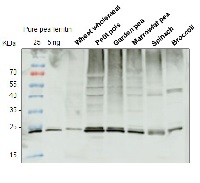1

Anti-Ferritin 1-2 (plant)
AS15 2898 | Clonality: Polyclonal | Host: Rabbit | Reactivity: A. thaliana, B. oleracea, H. vulgare, M. truncatula,. S. oleracea, P. sativum
- Product Info
-
Immunogen: Purified ferritin from dried peas, Pisum sativum L. After extraction from pea flour, the ferritin was further purified by gel filtration chromatography to >95% purity as estimated from a Coomassie-stained gel.
Antibody is most likely to bind to all ferritin isoforms from pea however it has not been confirmed as yet.Host: Rabbit Clonality: Polyclonal Purity: Immunogen affinity purified serum in PBS pH 7.4. Format: Lyophilized Quantity: 50 µg Reconstitution: For reconstitution add 50 µl of sterile water Storage: Store lyophilized/reconstituted at -20°C; once reconstituted make aliquots to avoid repeated freeze-thaw cycles. Please remember to spin the tubes briefly prior to opening them to avoid any losses that might occur from material adhering to the cap or sides of the tube. Upon reconstitution in water, store the antibody in 20 % glycerol (final) at -20°C. Tested applications: Western blot (WB) Recommended dilution: 1 : 5000-10 000 (WB) Expected | apparent MW: 23 kDa in legumes, 24 kDa (Arabidopsis thaliana)
- Reactivity
-
Confirmed reactivity: Arabidopsis thaliana, Brassica oleracea, Hordeum vulgare, Medicago truncatula, Pisum sativum, Spinacia oleracea Predicted reactivity: Glycine max, Oryza sativa
Species of your interest not listed? Contact us - Application Examples
-
Application example

Molecular weight markers (1); purified ferritin from Pisum sativum, 5 ng (2) and 0.5 ng (3); 5 µg of Pisum sativum total cell extract (4) ; 5 µg Arabidopsis thaliana total leaf extract (5). Proteins were separated on a 12% SDS-PAGE gel and transferred to nitrocellulose membrane using a semi-dry blotting apparatus. Blots were blocked in TBS, 0.1% (v/v) Tween-20, 5% (w/v) skimmed dried milk (TBS-TM) for 1 hour at RT. The antiserum was diluted 1: 5,000 in TBS-TM and incubated with the blot for 2 hours at RT. The blot was washed 3 times for 10 min with TBS-TM, then incubated with secondary antibodies anti-rabbit IgG HRP diluted to 1: 5000 in TBS-T for 1 hour. The blot was washed 4 times with TBS-T and developed with chemiluminescent detection reagent.
Courtesy of Dr. Janneke Balk, John Innes Centre, UK
Molecular weight markers, purified pea ferritin and 20 µg of plant cell extracts from various plant species depicted at the top of the image. Proteins were separated on a 12% SDS-PAGE gel and transferred to nitrocellulose membrane using a semi-dry blotting apparatus. Blots were blocked in TBS, 0.1% (v/v) Tween-20, 5% (w/v) skimmed dried milk (TBS-TM) for 1 hour at RT. The antiserum was diluted 1: 5,000 in TBS-TM and incubated with the blot for 2 hours at RT. The blot was washed 3 times for 10 min with TBS-TM, then incubated with secondary antibodies anti-rabbit IgG HRP diluted to 1: 5000 in TBS-T for 1 hour. The blot was washed 4 times with TBS-T and developed with chemiluminescent detection reagent.
Courtesy of Emily Jones, John Innes Centre, UK
- Additional Information
-
Additional information (application): Note, the calculated molecular weight of pea ferritin is 28 kDa. Removal of the N-terminal targeting sequence upon protein import into plastids results in a protein with an apparent mol weight of ~23 kDa.
This antibody is also recognizing horse ferritin (above 100 ng in Western blot). - Background
-
Background: Ferritin forms a 24-subunit cage for storage of mineral iron. In plants, ferritin is predominantly localized in the plastids, and its expression is upregulated in response to iron or oxidative stress. - Product Citations
-
Selected references: Truong et al. (2024). Apo-siderophores promote growth of iron-deficient Arabidopsis plants by mobilizing iron from roots to shoots and reducing oxidative stress in roots. Plant Stress, Volume 12, June 2024, 100488.
Jiang et al. (2022) Reactive effects of pre-sowing magnetic field exposure on morphological characteristics and antioxidant ability of Brassica juncea in phytoextraction. Chemosphere. 2022 Sep;303(Pt 1):135046. doi: 10.1016/j.chemosphere.2022.135046. Epub 2022 May 23. PMID: 35618056.
Bastow et al. (2018). Vacuolar Iron Stores Gated by NRAMP3 and NRAMP4 Are the Primary Source of Iron in Germinating Seeds. Plant Physiol. 2018 Jul;177(3):1267-1276. doi: 10.1104/pp.18.00478. - Protocols
-
Agrisera Western Blot protocol and video tutorials
Protocols to work with plant and algal protein extracts
Oxygenic photosynthesis poster by prof. Govindjee and Dr. Shevela
Z-scheme of photosynthetic electron transport by prof. Govindjee and Dr. Björn and Dr. Shevela - Reviews:
-
This product doesn't have any reviews.


